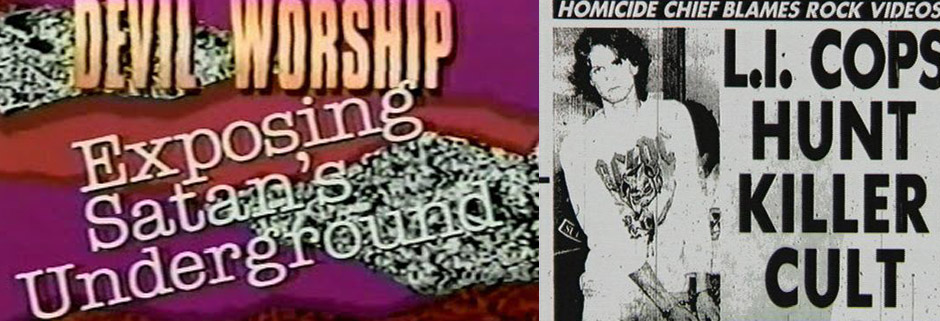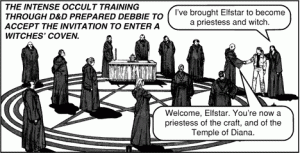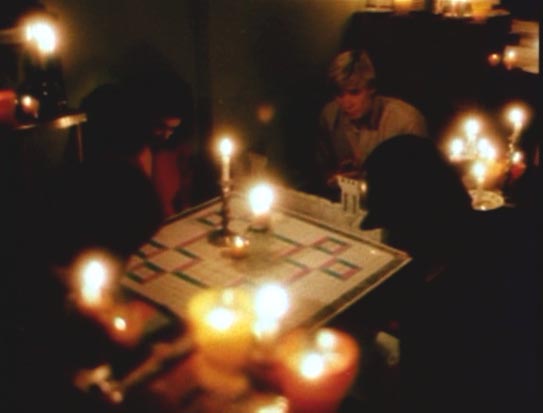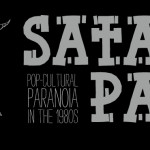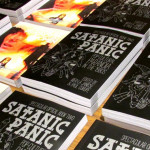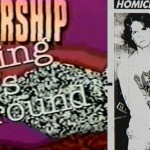THE GREATEST POP-CULTURAL PARENTAL SCARES OF THE 80s
From Quincy Punks to Satanic Panic, Kier-La Janisse looks back at an era gripped by pop-cultural paranoia
————————
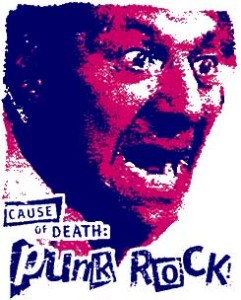 QUINCY PUNKS – When the notorious Quincy punk episode ‘Next Stop Nowhere’ aired in 1982, I was only ten years old and hadn’t even heard of punk rock. But that didn’t matter to my mother, who – like many parents across North America – was so freaked out by what she saw that she immediately set to work trying to instil her fear of this aggressive form of music into me, and enlisted other relatives to do the same (without success). What she didn’t realize was how ridiculous and off-the-mark television representations of punk tended to be in the 80s. The term ‘quincy punk’ became part of the vernacular almost overnight to refer to fake punks, but the episode – which depicted medical examiner Quincy facing off against a legion of nihilistic punks embroiled in a murder case – remained etched in the memories of terrified parents inundated at every turn by pop culture phenomena that threatened to steal their children away. There was a battle for the nation’s children in the 80s for sure, but in this era of mass-consumerism and product placement, it wasn’t a battle for their souls – it was a battle for their disposable income.
QUINCY PUNKS – When the notorious Quincy punk episode ‘Next Stop Nowhere’ aired in 1982, I was only ten years old and hadn’t even heard of punk rock. But that didn’t matter to my mother, who – like many parents across North America – was so freaked out by what she saw that she immediately set to work trying to instil her fear of this aggressive form of music into me, and enlisted other relatives to do the same (without success). What she didn’t realize was how ridiculous and off-the-mark television representations of punk tended to be in the 80s. The term ‘quincy punk’ became part of the vernacular almost overnight to refer to fake punks, but the episode – which depicted medical examiner Quincy facing off against a legion of nihilistic punks embroiled in a murder case – remained etched in the memories of terrified parents inundated at every turn by pop culture phenomena that threatened to steal their children away. There was a battle for the nation’s children in the 80s for sure, but in this era of mass-consumerism and product placement, it wasn’t a battle for their souls – it was a battle for their disposable income.
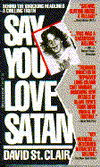 HEAVY METAL – Although many kinds of music came under attack from the religious right and the Parents Music Resource Center (co-founded in 1985 by Tipper Gore and “The Washington Wives”) alike, in the 1980s none was as much of a target as heavy metal, due not only to allegedly explicit lyrics but also because of the (societally constructed) links between heavy metal and the Satanic panic of the era. A few high-profile cases fanned the flames, in particular that of Long Island teenage heavy metal fan Ricky Kasso who – with the assistance of friends Jimmy Troiano and Albert Quinones – brutally murdered his classmate Gary Lauwers in a supposed Satanic ritual in 1984, beating and stabbing Lauwers for several hours while demanding “Say you love Satan” (later the name of a best-selling true crime novel about the case). This case and others were covered in a widely-watched 1985 20/20 news special “The Devil Worshippers” and it also became the basis for the films Where Evil Dwells (1986), My Sweet Satan (1994), Black Circle Boys (1997), Ricky 6 (2000) as well as the inspiration for Under Surveillance (2006) and one of the influences for the teenage cultural myopia depicted in River’s Edge (1986) – although the latter was directly inspired by the 1981 murder of Marcy Conrad.*
HEAVY METAL – Although many kinds of music came under attack from the religious right and the Parents Music Resource Center (co-founded in 1985 by Tipper Gore and “The Washington Wives”) alike, in the 1980s none was as much of a target as heavy metal, due not only to allegedly explicit lyrics but also because of the (societally constructed) links between heavy metal and the Satanic panic of the era. A few high-profile cases fanned the flames, in particular that of Long Island teenage heavy metal fan Ricky Kasso who – with the assistance of friends Jimmy Troiano and Albert Quinones – brutally murdered his classmate Gary Lauwers in a supposed Satanic ritual in 1984, beating and stabbing Lauwers for several hours while demanding “Say you love Satan” (later the name of a best-selling true crime novel about the case). This case and others were covered in a widely-watched 1985 20/20 news special “The Devil Worshippers” and it also became the basis for the films Where Evil Dwells (1986), My Sweet Satan (1994), Black Circle Boys (1997), Ricky 6 (2000) as well as the inspiration for Under Surveillance (2006) and one of the influences for the teenage cultural myopia depicted in River’s Edge (1986) – although the latter was directly inspired by the 1981 murder of Marcy Conrad.*
The year after the Ricky Kasso case, teenagers James Vance and Raymond Belknap shot themselves in a suicide pact after an evening of drinking, smoking weed and listening to Judas Priest. Belknap died instantly but Vance lived, horribly disfigured by the shotgun wound to his face, and his parents proceeded to sue the band Judas Priest, claiming that their music contained subliminal messages that had prompted the teens to commit suicide. The trial lasted for a month before being dismissed, and was documented in the PBS film Dream Deceivers: The Story of James Vance vs. Judas Priest (1991 – playing in Montreal on Sept. 25th as part of FilmPOP – details HERE). Vance eventually died in 1988 from a combination of drug abuse and complications resulting from his many facial surgeries.
The Satanic scare was everywhere in the 80s. Geraldo had his classic “Exposing Satan’s Underground” episode, Christian organizations released dozens of direct-to-video instructional tapes for worried parents, even daycare centers came under attack as hotbeds for Satanic ritual abuse.
Even innocuous am radio stars could not escape the Satanic fantasy of overprotective Christian parents – in the famously-mocked educational film Rock? It’s Your Decision a teenager realizes that he is committing a sin just by listening to rock music – and is seen holding up a Billy Joel record while voicing this realization.
DUNGEONS & DRAGONS – Dungeons and Dragons had been around since 1974, but it was in the 80s that this pioneering RPG really took off in notoriety – and infamy – because of the moral panic that surrounded it in the 80s, which saw it as a gateway to teenage Satanism and suicide. Because the game takes place in a fantasy realm that includes sorcery and demonic entities , religious organizations loudly railed against the game for instilling anti-Christian values in kids. Jack T. Chick’s famous comic “Dark Dungeons” from 1984 portrayed DnD circles as recruitment grounds for the Satanic cults that were supposedly proliferating in North America in the 80s (see Jack Chick’s 1984 comic “Dark Dungeons”). Virginia-based Patricia Pulling, who founded the one-woman organization Bothered About Dungeons and Dragons (BADD) and published the book The Devil’s Web: Who Is Stalking Your Children For Satan? in 1989 was one of the first loud campaigners against DnD, after her son, a DnD player, committed suicide in 1982. By the end of the 80s, TSR (the publisher of the game) removed all references to devils and demons from the game under pressure from these parental concerns (but they would be reinstated a decade later).
But even non-Christian parents were swayed by the hysteria, and started to fear the game as some kind of occult initiation, or at the very least, as an unhealthy activity for naturally antisocial kids who might become too dependent on the fantasy life of the game. Rona Jaffe’s 1981 book Mazes and Monsters was based on a real case that involved a University of Michigan student and sometime RPG player who had committed suicide. The media at the time had played up the role of the game in his death and Jaffe seized upon this to fashion a story about a dissociated kid who permanently ‘crosses over’ into the gameworld. It was made into a 1982 TV movie (starring Tom Hanks), and the widespread broadcast of this movie brought the issue home for many parents , Christian or not. I remember my Uncle Tom wrote Dungeons & Dragons supplements at the time, and I was instructed not to tell anyone about it because of all the controversy.
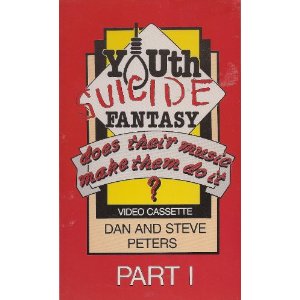 TEEN SUICIDE – If you ever watched TV in the 80s you would swear that teenagers were dropping like flies in suicide pacts, and with every manner of pop culture under attack as causal of suicidal behaviour it was easy to get swept up in the zeitgeist of parental concern. Teen suicide became a staple topic of television shows, from afterschool specials ( A Desperate Exit) to sitcoms, including a second-season Facts of Life episode in which one of the girls at Mrs. Garrett’s house is found dead from an overdose of sleeping pills, followed promptly by a wisecrack from Jo (laugh track intact!).
TEEN SUICIDE – If you ever watched TV in the 80s you would swear that teenagers were dropping like flies in suicide pacts, and with every manner of pop culture under attack as causal of suicidal behaviour it was easy to get swept up in the zeitgeist of parental concern. Teen suicide became a staple topic of television shows, from afterschool specials ( A Desperate Exit) to sitcoms, including a second-season Facts of Life episode in which one of the girls at Mrs. Garrett’s house is found dead from an overdose of sleeping pills, followed promptly by a wisecrack from Jo (laugh track intact!).
But although there was an increase in “cluster suicides” in the 80s – meaning that kids in the same geographical area would commit suicide within a short timespan of eachother (later parodied in Heathers, 1988) – teen suicide was not actually on the rise in the 1980s, despite what the media would have us think. Although the North American suicide rate in the 80s was shocking, it had not actually increased significantly since the 60s and 70s (although a 1990 study revealed that the Canadian suicide rate for teen males was 57% higher than in the US, and Quebec had one of the highest teen suicide rates in the world! (reference)
One of the greatest Christian propaganda films of the period was Youth Suicide Fantasy – brothers Dan and Steve Peters lecture us on how popular music ranging from Boy George to Van Halen imparts suicidal messages and encourages homosexuality! With interviews, clips and stills, this is one of the most hilarious tracts of the 80s Christian war on music. Another gem of the era – but much less hilarious – is That Teen Show, hosted by Haywood Nelson of What’s Happenin’ . In the episode “Teenage Suicide: Your Decision” diminutive actor Herve Villechaize and many teenagers are interviewed about their failed suicide attempts. One of the most painfully awkward and depressing 27 minutes you will ever experience, especially considering that Villechaize would successfully commit suicide a decade later.
VIDEO GAMES – It’s hard to imagine a public uproar being prompted by the simplistic visual equivalent of Pong, but that’s what happened in 1976 with the release of Death Race (based on the Paul Bartel film Death Race 2000), which was quite laughably considered an extremely violent video game at the time. But the 1980s video game explosion brought more competition that bred controversy in terms of game graphics and thematic content , and the early 80s brought us the immortal Castle Wolfenstein (1981, later released in a 3D version in the early 90s)- in which players would move through the rooms of a castle killing Nazis – and 1988 gave us the first ultraviolent video game that came under widespread attack from parental watchdog groups: NARC. The inevitable conclusion of the “war on drugs” decade, Narc allowed players to roam the streets picking off drug pushers and users with a machine gun and/or rocket launcher. Although players would get more points for arresting the offenders than killing them, supposedly imparting an empathic moral message, I think being armed with a rocket launcher sends its own message.
DRUGS – Like the suicide fad, the war on drugs created the impression that all teenagers in the 80s were strung out wasteoids. But while instant gratification was part and parcel of the ‘me’ generation, teenage drug use was nowhere near as rampant as the reaganomic propaganda machine would lead one to believe, mainly because the 80s drug of choice – cocaine – was too expensive! The only drugs average teens were doing habitually came from their pill-popping parents’ medicine cabinets.
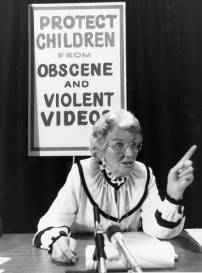 SLASHER FILMS – Since the beginning of the slasher film boom with Carpenter’s Halloween (yes, there were predecessors, but Halloween effectively kicked off the proliferation of these films that would colour the 80s horror film landscape), the subgenre has been maligned and dismissed, from inside as well as outside of genre circles. But aside from criticism coming from academic/feminist camps – which only helped to create the wealth of pro-horror academic writing we have today – slasher films were more of a moral issue for the general public in the UK than in North America in the 1980s. Sure, battles with the MPAA were regular fodder for mags like Fangoria, Deep Red and Gorezone, and every kid under 20 had a hate-on for Jack Valenti without really understanding why, but the MPAA was more of an affront to the burgeoning FX industry than anything else – the artistry of many FX craftspeople would lamentably be given the axe by the MPAA’s “suggested censorship” while the overall moral compass of the films would often remain unquestioned (Silent Night Deadly Night and Henry: Portrait of a Serial Killer being among the few exceptions).
SLASHER FILMS – Since the beginning of the slasher film boom with Carpenter’s Halloween (yes, there were predecessors, but Halloween effectively kicked off the proliferation of these films that would colour the 80s horror film landscape), the subgenre has been maligned and dismissed, from inside as well as outside of genre circles. But aside from criticism coming from academic/feminist camps – which only helped to create the wealth of pro-horror academic writing we have today – slasher films were more of a moral issue for the general public in the UK than in North America in the 1980s. Sure, battles with the MPAA were regular fodder for mags like Fangoria, Deep Red and Gorezone, and every kid under 20 had a hate-on for Jack Valenti without really understanding why, but the MPAA was more of an affront to the burgeoning FX industry than anything else – the artistry of many FX craftspeople would lamentably be given the axe by the MPAA’s “suggested censorship” while the overall moral compass of the films would often remain unquestioned (Silent Night Deadly Night and Henry: Portrait of a Serial Killer being among the few exceptions).
But in the UK, these films – which were included among the Video Nasties list initiated by Christian moral watchdog Mary Whitehouse – were seen as indicative of society in serious decline. Ironically the whole fury over the Video Nasties was effectively started by the UK distributors for Cannibal Holocaust as a publicity stunt. They sent a copy of the film and a fake “complaint” letter to Mary Whitehouse, whose influential campaign against the film and others of its ilk resulted in the creation of the Department of Public Prosecutions’ Video Nasties list in 1983, and the passing of the Video Recordings Act in 1984, which made it illegal for any film to be sold in the UK without certification by the BBFC (similar to the compulsory ratings system we have in Canada). Of course the Nasties list was not limited exclusively to slasher films, and contained things as varied as The Beast in Heat and Argento’s Inferno, but the morally bankrupt nature of many golden-era slasher films certainly made them high on the priority list.
Of course the pinnacle of these concerns would come in the next decade, when 3 year old Jamie Bulger was found dead in 1993, the victim of an abduction and brutal beating by 10 year old kids Robert Thompson and Jon Venables. The media made much of the fact that the two pre-teen assailants had seen Child’s Play 3, and every horror fan on the planet was suddenly aware of this case and how it might affect their viewing habits. Ultimately the Chucky angle was thrown out, but it did result in more restrictive video laws in Britain (reference). The crime also resulted in a ban on the Dennis Dimster film Mikey (1992) about a child sociopath, a ban that is still in effect to this day. In another coda to the story, a 2007 video game based on the Law & Order TV show was recalled from stores in the UK when it was proven to contain the infamous CCTV image of Bulger being led away by his killers.
——————————
Do you have an anecdote about a pop-cultural parental freakout from your childhood or adolescence? Share it in the comments below!
*This reference to the Marcy Conrad murder is an amendment added June 1, 2014, as I had previously mistakenly referred to the Ricky Kasso case as the primary influence for the film River’s Edge.

 September 1, 2011
September 1, 2011  1 Comment
1 Comment
